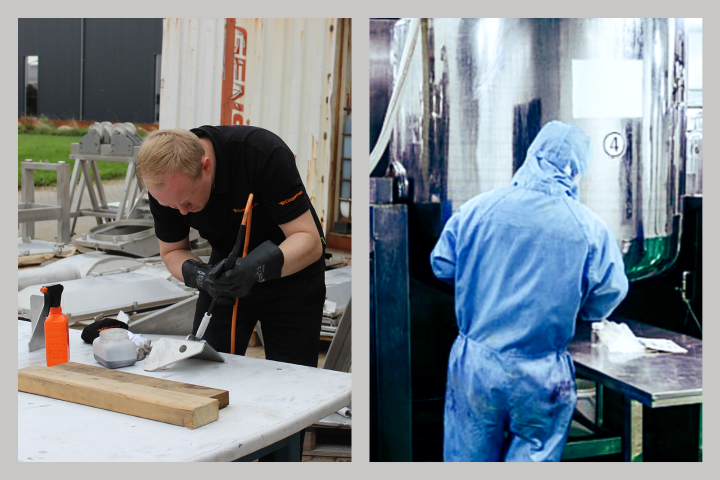The most environmentally friendly weld cleaning method
Weld cleaning | Thursday, 06 December 2018
Cougartron - The most environmentally friendly weld cleaning method
Profit maximization is the ultimate goal of every company.
However, this does not mean that we should ignore social responsibility and pursue profit at the expense of the environment.
This is very important to emphasize when it comes to metal fabrication as this industry has an enormous impact on the natural environment.
The adoption of environmentally friendly practices and sustainable methods of production is a prerequisite for reversing some of the harmful side-effects of modern industrialization.
But how is this related to weld cleaning?
As with all industrial activities, weld cleaning and surface passivation can be done in several different ways. Some of them are, naturally, much more harmful than others.
Therefore, one of the important first steps is the abandonment of harmful methods that are proven to be hazardous to both the human body and the environment.
Chemical pickling is an obvious example.
The adverse effect of chemical pickling
Pickling is mainly done with the help of special chemical pickling baths or by applying the pickling paste manually to the metal surface.
In both cases, the chemicals used are of similar composition.
Namely, two types of acids are commonly found in commercial products – hydrofluoric and nitric acids.
Hydrofluoric acid is the liquid form of hydrogen fluoride gas. Fluorine, the main ingredient, is highly reactive and toxic. Rigorous regulations related to handling, storage, and disposal of hydrogen fluoride compounds (including the pickling paste) exist for a reason.
Any form of contact with the human body can cause significant consequences including tissue disintegration and various chronic conditions.
The presence of hydrogen fluoride in water can be detrimental to organisms populating this habitat. Evaporation can increase the concentration of this substance in the air and result in acidic precipitations which can negatively affect the local flora and fauna.
The pickling paste and the resulting toxic waste cannot be dissolved organically so they have to be stored in special storage units. This puts an additional burden on the disposal to limit and reduce the harmful effect of industrial production.
Nitric acid is also associated with a number of negative environmental impacts.
- This type of acid is produced when nitrogen oxides react with water in a process that occurs naturally or artificially. Similar to hydrofluoric acid, nitric compounds also pose a huge threat to all living organisms including wildlife.
- It is of utmost importance to prevent the acid from reaching the local ecosystem. Unfortunately, human negligence and accidents often lead to pollution through spilling, drainage, and evaporation (fumes).
- Both types of acids used during chemical pickling are aggressive and corrosive. The results obtained depend on their chemical potency. Unfortunately, this is highly unfavorable as it is very difficult to prevent harmful particles from also affecting the local environment.
READ MORE: 5 Reasons to Drop Pickling Paste Right Now
Therefore, the implementation of healthier and more secure weld cleaning solutions comes with a real urgency.

Safety of electrolytic method
Unlike chemical pickling, electrolytic treatment of metal surfaces is carried out by means of a weak electric current and fluids that are milder and non-dangerous to the surroundings.
Actually, there are no strict regulations concerning the application of this weld cleaning method. However, there are several guidelines to follow if you want to achieve complete peace of mind when working with this type of equipment.
Protective gloves and goggles are the recommended PPE and, you should always have them at your fingertips for safer working conditions. If you work indoors, make sure that your work area is always properly ventilated. However, by comparison with traditional methods, this is far safer.
You can use electrochemical systems off- and on-site without worrying about damaging the local ecosystem.
Electrolytic weld cleaning fluids are phosphorus-based and very similar to your ordinary household cleaning products. Therefore, they do not pose a major threat to your local flora and fauna when they evaporate. Additionally, we recommend you always use a neutralizer at the end of the cleaning process and thus reduce and eliminate the pH acidity of the waste material.
Read more: Electrochemical Weld Cleaning – The Fastest and Safest Way to Clean Stainless Steel Welds
Cougartron Weld Cleaning Machines
Loading products...
Please wait while the products load.
Cougartron Weld Cleaning Fluids
Loading products...
Please wait while the products load.


 English
English  English (US)
English (US)  German
German  Danish
Danish  Swedish
Swedish  French
French  Polish
Polish  Spanish
Spanish